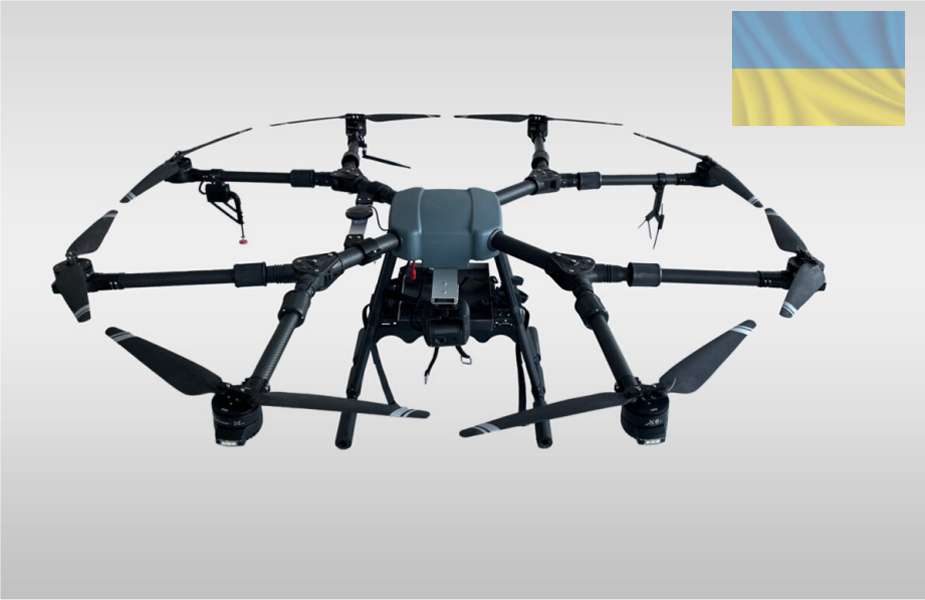- Army
- Conflicts in the world
- Israel - Iran conflict 2025
- Pakistan - India Conflict 2025
- Russia Ukraine War 2022
- Libya conflict day by day
- HAMAS - Israel War 2023
- Operation Serval in Mali French Army
- Sangaris operation Central African Republic
- Sangaris opération militaire République Centreafrique
- Ukraine - Russia conflict
- Syria conflict news
- Defence & Security Industry Technology
- Armies in the world
- Analysis Defense and Security Industry
- Conflicts in the world
- Navy
- Air
Ukrainian farm octocopter drone reinvented as Velikiy Banderik military tool
According to an article by ArmyInform on August 23, 2023, Ukrainian military personnel have introduced a new octocopter drone called Velikiy Banderik. It originated from the adaptation of agricultural UAVs initially designed for irrigation, commencing on March 8, 2022. After evaluating several options, the octocopter configuration was chosen due to its perceived stability in demanding conditions.
Follow Army Recognition on Google News at this link

Ukrainian farm octocopter drone reinvented as military tool called Velikiy Banderik (Picture source: ArmyInform)
Maksym, the head of the manufacturing company, elucidates the core features of the "Velikiy Banderik." Equipped with eight engines, it can accommodate a load of up to 31.5 kilograms, including an 8-kilogram payload. This aligns with the typical robustness of octocopters in handling increased weight. Its ability to withstand wind and external factors corresponds to the recognized stability of octocopter designs.
Beyond its physical attributes, the drone includes a payload release mechanism and a universal ground station, facilitating remote control of various UAVs from different locations globally through an integrated network connectivity system.
An incident in February during an active combat mission highlighted the drone's ability to cover a distance of 7 kilometers even with an enemy bullet lodged in one of its motors. This occurrence underscores the redundancy aspect of octocopters, wherein the failure of a rotor or rotors does not necessarily result in a loss of flight.
Tests conducted in February 2023 provided insights into the Velikiy Banderik's performance under electronic warfare (EW) conditions. Functioning amid heavy snowfall and wind speeds of up to 10 meters per second, the drone successfully completed the testing, distinguishing itself among the six participating manufacturers in the trials.
Maksym acknowledges the support extended by military personnel overseeing the Ministry of Defense's approval process, which expedited the drone's authorization for operational deployment.
Utilizing agricultural octocopter drones for military applications, encompassing the capability to deploy munitions, offers several potential advantages. These benefits arise from adapting existing technology initially designed for agricultural tasks, which confers specific inherent advantages for military contexts.
An advantage lies in the cost-effectiveness of repurposing existing agricultural drones. Developing entirely new military drone platforms can incur substantial expenses related to research, development, and production. Utilizing drones that are already available and proven in other fields can result in cost savings. Agricultural drones are already operational, enabling their swift adaptation for military purposes. This rapid deployment could be especially valuable in situations necessitating quick responses, where the development of new technology might be time-consuming. Agricultural drones are engineered to withstand challenging operating conditions, rendering them durable. Consequently, they tend to be relatively straightforward to maintain and repair. This aspect could prove advantageous in military environments where prompt maintenance is critical.
Octocopters possess a versatile design and can be easily customized for various functions. Agricultural drones can carry cameras, sensors, and other equipment for diverse tasks. This adaptability extends to incorporating munitions for military use. The multiple rotors of octocopters confer stability during flight, a pivotal attribute for precise payload delivery, even under adverse weather conditions or difficult terrains.
Agricultural drones are deliberately designed to generate minimal noise to prevent disturbing animals and crops. This diminished noise signature could be advantageous in military operations requiring stealth. Agricultural octocopter drones can fulfill various military roles. They can serve for reconnaissance, surveillance, target identification, and, with modifications, as payload delivery platforms. This versatility could heighten their utility across different combat scenarios.
Employing drones in specific military operations could mitigate risks to human personnel, particularly in hazardous or high-risk settings. Drones can execute tasks in areas that might pose dangers to soldiers. This could catch adversaries off guard. These opponents might not immediately recognize these devices as potential military tools, potentially furnishing a strategic advantage.
If military personnel are already trained to operate and maintain agricultural drones, transitioning to utilize these drones for military purposes could be more streamlined. Familiarity with the technology might expedite the learning process.


























